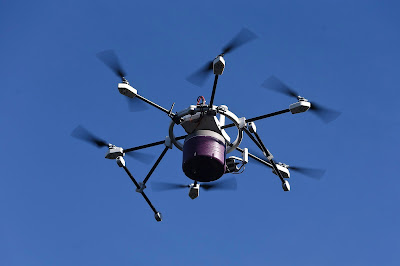Protection from Drones
 |
| A delivery drone in Portugal, December 2016. Credit: Eduardo Famendes. CC 4.0 SA |
A small, unarmed drone can bring down aircraft. Malicious operators can use them to attack soft targets beyond airports. For deterrence to work, identifying drone pilots must be easier. Manufacturers can help by spearheading enforceable industry standards.
Unmanned aerial vehicles (UAVs), aka drones, pose a serious threat to aviation. For the most part, this is not because they are carrying crude bombs (although they can be rigged to do so) but because a jet engine sucking up a bunch of flying metal will be severely damaged. Smashing into other parts of an airplane can also cause hazardous damage. This is why drone operators in the US must fly drones within the line of sight, avoid aircraft, notify air traffic control if flying within five miles of an airport, and are prohibited from flying close to airports. Nevertheless, drone strikes do occur and is it not uncommon for airports to shut down due to drone sightings. So what can be done?
There are defensive systems designed to identify and disable, destroy, or divert drones. There are issues with these, however. Disabling a drone midair could cause it to crash and injure someone or damage something important. Destroying a drone could leave behind dangerous debris. The equipment used for that destruction could itself also cause damage: think bullets flying for miles and striking someone, lasers hitting aircraft, jamming devices endangering aircraft communication or navigation, or pulses to disable electronics damaging aircraft. Moreover, it is impossible to defend every potential drone attack target.
What about deterring operators? There are already stiff penalties in place for endangering aircraft with drones, as well as for, say, setting off bombs carried into concert crowds or onto rooftops by drones. The potential for such malicious use means that work on the defensive systems mentioned above must continue, but there are steps that would improve deterrence as well. Unique identifiers for drones and their operators, stored in a central database with mandatory owner-change updates, would help to catch and prosecute ignorant operators and amateur troublemakers (i.e., those who lack the skills to disable or work around such restrictions). More sophisticated malefactors would quickly hack/file off such identifiers and find ways around the rules. Standard policework, like fingerprinting and swabbing for DNA on rotor blades, would have to suffice. These could be made easier by central database information being made available to police when a drone is stolen.
Drone manufacturers would do well to proactively work on providing and standardizing ID solutions for their drones, safety controls that prevent use of the drone when its GPS or other safety or navigational systems are disabled, and otherwise making it harder for the ignorant and the malicious alike to endanger others without revealing their identities and the location of the drones themselves. Deterrence doesn’t have to be perfect to make a difference, and anti-drone technology will continue to improve, providing better protection for high-value targets like airports and concert venues. Drones have so far done a lot of good, but their Wild West days need to come to an end if they're to continue to do so.


Comments
Post a Comment